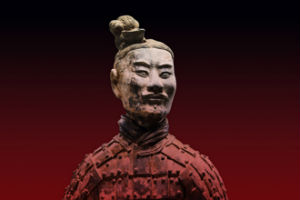
NEW YORK – “Age of Empires: Chinese Art of the Qin and Han Dynasties (221 B.C.-A.D. 220),” a landmark exhibition of ancient Chinese art will remain on view at the Metropolitan Museum of Art through July 16.
Showcasing more than 160 works—including renowned terra-cotta army warriors—the exhibition illuminates the unprecedented role that art played in creating a lasting Chinese cultural identity. Drawn exclusively from museums and archaeological institutes in the People’s Republic of China, the majority of the works have never before been seen in the West.
Other highlights include a recently discovered life-size sculpture of a seminude performer; scholars speculate that the work’s anatomical accuracy—hitherto unknown in Chinese figural art—was inspired by Hellenistic sculptures that Alexander the Great introduced into Central Asia a century earlier.
“The Han Empire represents the ‘classical’ era of Chinese civilization, coinciding in importance and in time with Greco-Roman civilization in the West. Like the Roman Empire, the Han state brought together people of diverse backgrounds under a centralized government that fostered a new ‘Chinese’ identity. Even today, most Chinese refer to themselves as the ‘Han people’—the single largest ethnic group in the world,” said Jason Sun, curator of Chinese Art in the Met’s Department of Asian Art. “Thanks to new scholarship as well as the extraordinary artifacts unearthed by archaeologists in the past 50 years, this exhibition offers many new art-historical, cultural, and political insights.”
The unification of China by the short-lived Qin dynasty (221–206 B.C.) and the centuries-long Han dynasty (206 B.C.–A.D. 220) fundamentally reshaped art and culture and established political paradigms and intellectual institutions that guided dynastic rulership for the next 2,000 years. They have continued to be influential to the present day.
Introducing an era of political stability and prosperity across an area much larger than that of the Roman Empire at its peak, the Han dynasty bound together its empire through a network of roads and a centralized administrative system that promulgated a unified legal code and standardized currency, weights and measures, and, most importantly, a consistent written language. These changes—first introduced under the Qin—fostered a “golden age” in art, architecture, technology, and literature while introducing lasting changes to society, the economy, religion, and political thought.



